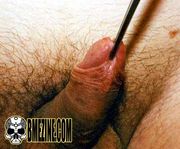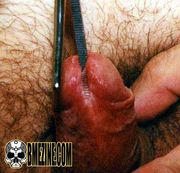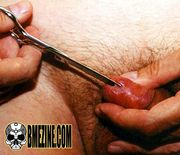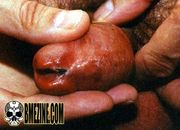Clamp and Cut
From BME Encyclopedia
A clamp and cut procedure is a method of bisection that involves first clamping the tissue to be split and crushing it paper-thin, then cutting through the damaged tissue. Most commonly this is used for a meatotomy or subincision, or less commonly on a scrotal split. In very rare cases some practitioners have used it for tongue splitting.
Put simply (too simply to serve as a "manual"), below are the steps typically involved in these procedures. Not all are always used, and there is variation between practitioners:
- (optional) A small amount of anesthetic (either topical such as EMLA, or injectable) is applied to the tissue to be cut and allowed to take effect.
- (optional) Restrict blood flow to the part of the anatomy being worked on, in order to reduce bloodflow and play. In the case of the penis, this might be a simple rope tie-off, or a specific tool such as a Zipser Clamp.
- The tissue to be cut is clamped using hemostats (sort of like needle-nosed pliers with ratchets; available at electronics stores) or even more primitive tools such as vice-grips. The clamp is tightened as fully as possible, so that the tissue is totally compressed. A partial crushing will be painful, damaging, and invalidate the benefits of this step.
- This clamp is usually left on for an utter minimum of fifteen minutes (usually about forty-five minutes, with some people choosing radically longer periods such as a full day).
- When the clamp is removed, the tissue should be paper-thin and translucent. If it is not, the clamping was either not tight enough, or not left on for long enough. If there is still bloodflow to the tissue after removing the clamps, however minor, they may as well have not been used in the first place. (It should also be noted that at this point the person can still abort the procedure and in most cases—certainly in the case of genital cutting—the tissue will fully reinvigorate itself.)
- The cut is then made through the centre of this crushed tissue to the desired length. Some people prefer scissors—a pair of surgical scissors is useful, as the rounded end is comfortable enough to insert into the urethra. Other people recommend serrated scissors, which grip the tissue and keep it from slipping. Still others prefer to use a scalpel, often cutting along a sound (perhaps with a groove) used as a backing.
- (optional) Silver nitrate or a similar coagulant may be used to minimize any bleeding, although if the tissue was properly crushed it should already be minimal. A cautery pen or other heat-based device can also be used to close any bleeders, though some feel that this also limits regrowth.
- (optional) In most cases the incision needs to be sutured (which isn't easy if you don't know how). Suturing is not usually required for a meatotomy, which does not tend to close much, but if you don't suture a subincision, it may close nearly entirely during healing. Aboriginal Australians used thorns to close theirs.
- If blood supply to the modified body part was being restricted, that device should be removed at this point. Further bleeding can be controlled by bandaging and applying direct pressure to the wound.



